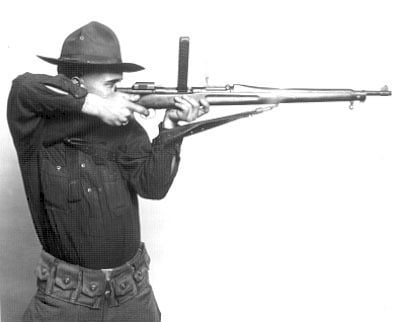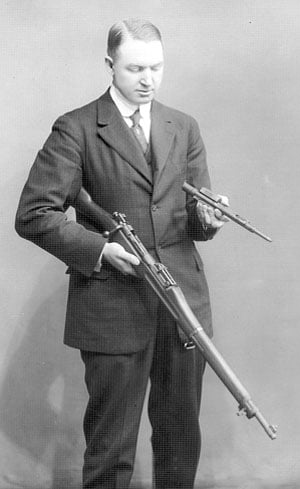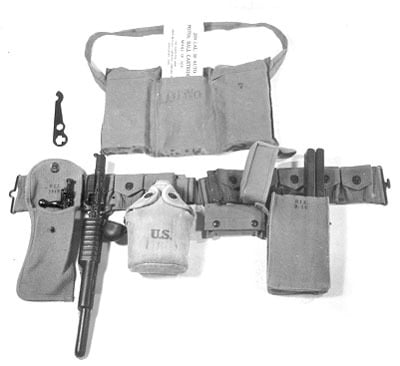
On March 16, 1915,
independent gun designer John D. Pedersen wrote a
hand-written letter to the Vice President of Remington
Arms and Ammunition Company, stating that he had
designed a prototype, autoloading military rifle. VP
Pryor then began a series of negotiations with the
Ordnance department, culminating in a go-ahead for
full, top-secret development.
On October 8th, Chief of Ordnance General William
Crozier, a few Ordnance Officers and some Congressmen,
all sworn to secrecy, attended Pedersen’s first
official demonstration of his invention–an automatic
bolt which changed the Springfield M1903 from
bolt-action to autoloading! This would later be known
as the Pedersen Device, but in late-1917, it was a
top-secret weapon.

On December 9, 1917, the device was tested by an
Ordnance Board in France, and it received a strong
recommendation that 100,000 be procured for the
infantry as soon as possible. To maintain the highest
levels of secrecy, a misleading name was given to the
device, and it was officially adopted as the Automatic
Pistol, Caliber .30, Model 1918, Mark I. An order was
subsequently placed with Rem-UMC for 100,000 Pedersen
Devices on March 26, 1918, and it was soon-after
increased to 133,450 devices.
Since this would be the “secret weapon” that would lead
thousands of American troops against the enemy trenches
in the upcoming 1919 Spring Offensive, the Ordnance
Department decided that even more Pedersen Devices were
necessary. Therefore, on June 27, 1918, J.D. Pedersen
was ordered to adopt his device to the M1917 Enfield
Rifle, and it became known as the M1918 Pistol, Mark
II. On September 20th, the Ordnance Department ordered
Remington to manufacture 500,000 Mark II devices once
the original Mark I contract was completed.
The Pedersen Device replaced the standard Springfield
(or Enfield) bolt, which the soldier would place into a
canvas pouch on his equipment belt. Removing the
Pedersen Device from a metal container hanging on the
belt, the soldier would insert it into the open breech,
and lock it in place by the rifle’s magazine cut-off.
Then the soldier would take a long, black magazine
holding forty pistol-sized cartridges and snap it in
place, it protruding from the right side of the breech
at a 45 angle. The soldier then had a 40-round,
autoloading weapon that could fill the air with
bullets. Each time the trigger was pulled, the Pedersen
Device mechanism fired a round.

The ammunition was officially known as “Cal. 30 Auto.
Pistol Ball Cartridges, Model of 1918”, and were packed
40-rounds per box (one magazine load), five boxes per
carton, and three cartons per canvas bandolier. Five of
these loaded bandoliers were packed in a wooden packing
crate. Even though the cartridge resembled a pistol
cartridge, the bullet had a muzzle velocity of 1,300
feet per second, nearly twice the velocity of a pistol
round.
Only minor modifications to the standard Springfield
(or Enfield) were necessary to adopt it to take a
Pedersen Device, including milling out the ejection
port on the left side of the receiver, cutting out a
small portion of the stock underneath the ejection
port, modifying the magazine cut-off, and modifying the
trigger which tripped the device firing mechanism. The
modified Springfield rifle was officially known as the
U.S. Rifle, Caliber .30, Model of 1903, Mark I, and
could still fire the standard .30-06 service cartridge
with replacement of the bolt. Springfield Armory did
the rifle modifications. Production of the Mark I
Devices commenced in secrecy at Remington’s Bridgeport
facility in 1918, and continued even when the Armistice
was declared on November 11, 1918.
On December 17th, the Ordnance Department canceled the
Mark II contract, however production of the Mark I
Devices continued until the order for cancellation was
issued on March 1, 1919. Rem-UMC had completed and
delivered exactly 65,001 Mark I Devices and some
65,000,000 cartridges by this date. Springfield Armory
continued modifying Springfield rifles until March
1920, at which time about 145,000 M1903, Mark I Rifles
had been fabricated.
The Pedersen Device, the wonder weapon of the first
World War, was completed too late to see action.
Inexplicably, nearly all of these devices were
destroyed in the early 1920s, making a surviving device
a true rarity in the field of collecting.
